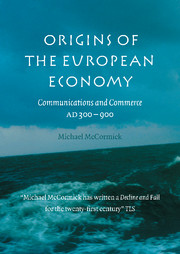Book contents
- Frontmatter
- Dedication
- Contents
- List of maps
- List of figures
- List of tables
- List of charts
- Preface
- List of abbreviations
- Commerce, communications, and the origins of the European economy
- PART I THE END OF THE WORLD
- PART II PEOPLE ON THE MOVE
- 5 A few western faces
- 6 Two hundred more western envoys and pilgrims: group portrait
- 7 Byzantine faces
- 8 Easterners heading west: group portrait
- 9 Traders, slaves, and exiles
- People on the move
- PART III THINGS THAT TRAVELED
- PART IV THE PATTERNS OF CHANGE
- PART V COMMERCE
- Appendices
- Bibliography
- Index
9 - Traders, slaves, and exiles
from PART II - PEOPLE ON THE MOVE
Published online by Cambridge University Press: 05 February 2015
- Frontmatter
- Dedication
- Contents
- List of maps
- List of figures
- List of tables
- List of charts
- Preface
- List of abbreviations
- Commerce, communications, and the origins of the European economy
- PART I THE END OF THE WORLD
- PART II PEOPLE ON THE MOVE
- 5 A few western faces
- 6 Two hundred more western envoys and pilgrims: group portrait
- 7 Byzantine faces
- 8 Easterners heading west: group portrait
- 9 Traders, slaves, and exiles
- People on the move
- PART III THINGS THAT TRAVELED
- PART IV THE PATTERNS OF CHANGE
- PART V COMMERCE
- Appendices
- Bibliography
- Index
Summary
Of their own free will, early medieval people crossed the Mediterranean in order to trade or to raid as well as to negotiate or pray. Some sought careers in the ancient capital on the Bosporus; others immigrated to Europe. Others still traveled under dire compulsion, as exiles, refugees, hostages, or as slaves. In most cases, their numbers probably were much greater than the high, mighty, and holy who dominate surviving sources. But people of low, suspect, or ambiguous social status appear more rarely and less completely in the early medieval written record. A fair number are of uncertain geographic origin – shippers and traders, for instance, attract only passing mention in sources treating the more important people who traveled aboard their vessels. Where was the home berth of the six slavers that Bernard the Frank saw anchored in the harbor of Taranto in 867? We may surmise, but we do not really know; nor can we do more than speculate on the ethnicity of the merchant skipper with whom St. Blaise sailed from Rome to Greece. The smaller numbers of these kinds of travelers make it more practical to treat together easterners and westerners. We will begin, again, with a few thumbnail sketches and meet some merchants, a slave, and a refugee. We will also test the anecdotes against the broader group of like travelers, combining this time the scarcer data of east and west.
- Type
- Chapter
- Information
- Origins of the European EconomyCommunications and Commerce AD 300–900, pp. 237 - 269Publisher: Cambridge University PressPrint publication year: 2002



